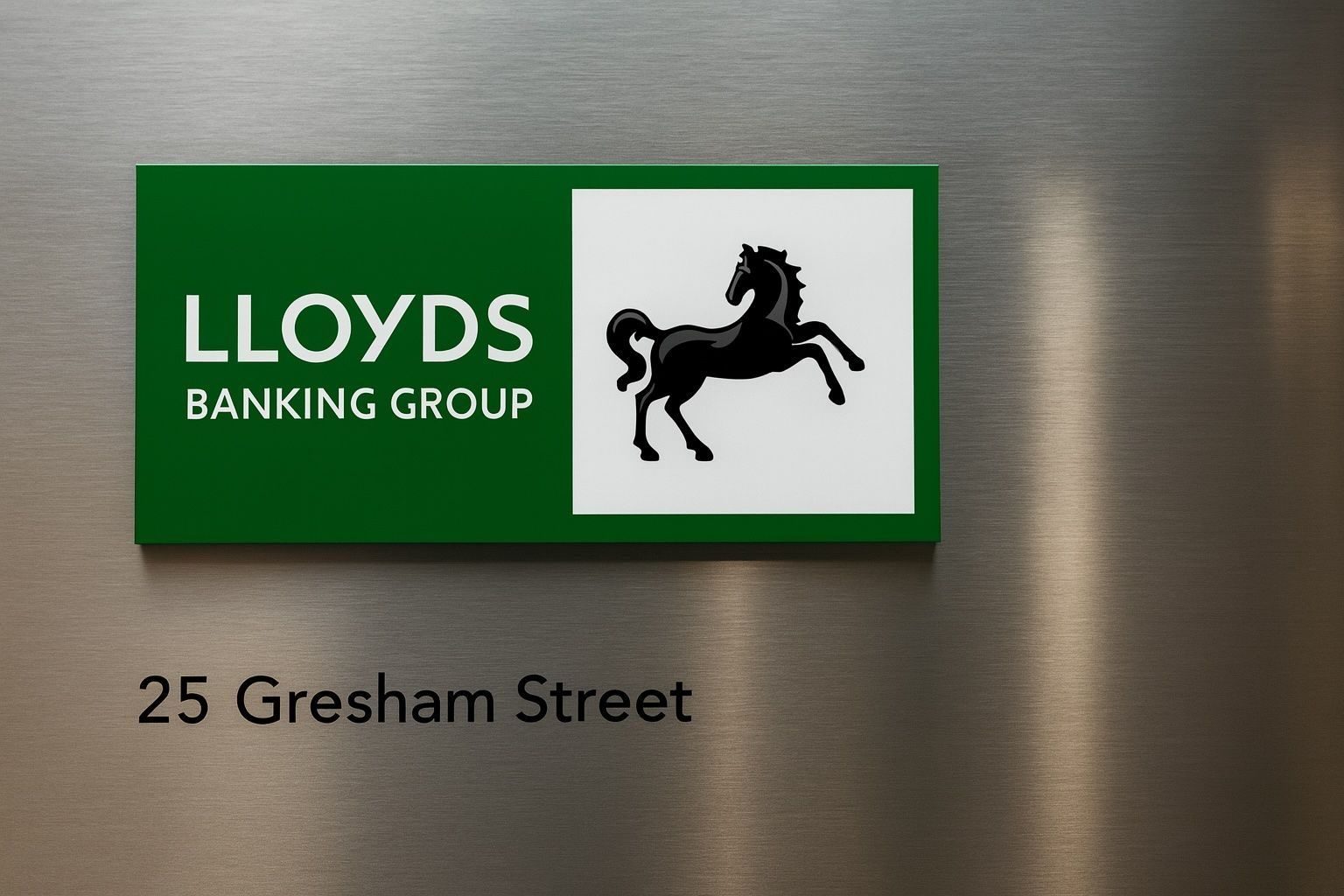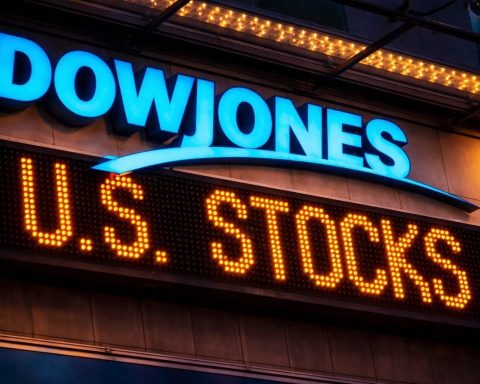Lloyds Banking Group’s share price eased slightly on Friday but remains close to a new 52‑week high, capping a powerful post‑Budget rally for UK bank shares.
Lloyds share price today: still around 96p after touching a new high
On Friday 28 November 2025, Lloyds Banking Group (LON: LLOY) closed at 96.14p on the London Stock Exchange, down around 0.5% on the day. The stock traded in a range of 95.96p to 96.92p, with the top of that range marking a new 52‑week high of 96.92p. [1]
Trading volume was just over 48 million shares, lower than the very heavy turnover seen earlier in the week as investors reacted to the UK Budget. [2]
By contrast, the FTSE 100 index inched higher, closing up roughly 0.4–0.5% on the day and extending its recent gains, with the benchmark now up about 17–18% over the past year. [3]
Despite today’s small dip, Lloyds remains one of the standout performers on the index:
- 1‑week performance: +10.5%
- 1‑month performance: +10.0%
- 1‑year performance: +81.6%
- 52‑week range: 52.44p – 96.92p [4]
Lloyds also now carries a market capitalisation of around £56–57 billion, a P/E ratio of about 19.7x, and a trailing dividend yield of roughly 3.3% based on recent payouts. [5]
Big picture: a powerful week driven by Reeves’ Budget and bank tax relief
The move in Lloyds this week can’t really be separated from Westminster.
In the days leading up to and immediately after Chancellor Rachel Reeves’ 26 November Budget, UK bank stocks staged a strong rally as it became clear that no new, sector‑specific tax raid would be imposed on lenders:
- On 25 November, UK bank shares jumped after reports suggested Reeves would spare banks from a punitive new levy in the Budget, with Lloyds, NatWest and Barclays all surging around 3–4%. [6]
- On 26 November, following confirmation in the Budget that no additional bank tax was coming, bank stocks again outpaced the wider market. Reuters reported that Lloyds rose about 3.8%, helping to drive a sector‑wide rally. [7]
You can see that effect clearly in the day‑by‑day price history:
- 25 November: +3.78%
- 26 November: +3.44%
- 27 November: +2.99%
- 28 November: ‑0.48% (a mild consolidation) [8]
In other words, today’s softness looks more like a pause after a surge than a change in trend. The stock is still within a whisker of its new high and has nearly doubled from its 52‑week low.
Fresh news today: confidence, capital buffers and share count
Several new announcements dated 28 November 2025 help explain what’s sitting behind today’s share price narrative.
1. Lloyds Business Barometer: confidence down but still above average
Lloyds published its latest UK Business Barometer showing that:
- Overall business confidence fell 8 points to 42% in November.
- That’s above the long‑term average of 30%, but down from October’s more upbeat levels.
- Confidence in firms’ own trading prospects dropped 9 points to 53%, while economic optimism fell 8 points to 31%.
- 56% of firms still expect to increase headcount over the next year (down from 60%), with 17% expecting to reduce staff.
- Price pressures are easing a bit: the net balance of firms planning price rises fell to 60%, with 64% expecting to raise prices and 4% expecting to cut them. [9]
The tone is one of softening momentum rather than outright weakness. For Lloyds’ share price, this matters because:
- It feeds into expectations for loan demand in 2026.
- It hints at slightly less inflationary pressure, which could influence interest rate expectations and bank margins.
The combination — still‑healthy but easing confidence — helps explain why the share price has held near highs but not pushed decisively above 97p today.
2. New capital buffer decision: O‑SII rate set at 2.0%
The Bank of England’s Prudential Regulation Authority (PRA) also published updated Other Systemically Important Institution (O‑SII) buffer rates today. For the Lloyds Banking Group ring‑fenced bank (RFB) sub‑group, the PRA set: [10]
- O‑SII buffer: 2.0% of risk‑weighted assets
This buffer, which applies from 1 January 2027, is designed to make sure systemically important banks like Lloyds hold extra capital to protect the financial system. While not an immediate earnings headwind, it:
- Reinforces the expectation that Lloyds will continue to run with solid capital ratios.
- Slightly constrains how aggressively the bank can return capital over the very long term, but investors have largely priced in this kind of requirement for years.
Given that Lloyds is already well‑capitalised, the announcement looks incrementally neutral for the share price — but it supports the argument that the bank is structurally safer, which long‑term investors tend to like.
3. Total Voting Rights: share count confirmed at 58.93 billion
Lloyds also released a Regulatory News Service (RNS) announcement titled “Notification of Voting Rights and Capital”, confirming the share count that underpins all per‑share metrics: [11]
- As at 28 November 2025, the group has 58,933,895,530 ordinary shares of 10p each in issue.
- All of these carry voting rights and none are held in treasury.
This figure is the denominator used by shareholders when calculating whether they must notify major holdings under the FCA’s Disclosure Guidance and Transparency Rules. In practice, it also reassures investors that recent share buybacksare being reflected in a slightly reduced share count over time.
4. Ongoing share buybacks: 257,096 shares repurchased
Those buybacks continued this week. In a Form 6‑K filed with the US SEC, Lloyds reported that on 27 November 2025it: [12]
- Repurchased 257,096 ordinary shares from Morgan Stanley & Co. International.
- Paid between 93.4600p and 93.7000p per share, at a volume‑weighted average price of 93.5892p.
- Intends to cancel these shares as part of its previously announced share buyback programme.
While 257k shares is tiny versus the nearly 59bn shares in issue, consistent buybacks:
- Provide a floor under the share price during weaker days.
- Gradually improve earnings per share (EPS) and the dividend per share profile.
5. Institutional interest in the ADR
On the US side, Lloyds’ New York‑listed ADR (NYSE: LYG) also saw institutional activity highlighted today. Global Retirement Partners LLC disclosed a new position of 427,337 shares, valued at about $1.82 million, in a fresh 13F filing. [13]
MarketBeat notes that a string of other institutional investors have been increasing positions as well, although overall US institutional ownership remains relatively modest. [14]
Taken together, today’s newsflow paints a picture of a bank that is:
- Operating in an economy where confidence is cooling but still healthy.
- Subject to clear, manageable capital rules from regulators.
- Persistently returning cash to shareholders through buybacks and dividends.
- Attracting steady institutional interest, especially in the US.
Performance vs FTSE 100 and other UK banks
With its move to the mid‑90s pence, Lloyds is now:
- Up about 81–82% over the past 12 months, versus roughly 17–18% for the FTSE 100. [15]
- Near the top end of its 52‑week range (52.44p – 96.92p). [16]
Rallies across the big UK banks have been driven by:
- Stronger net interest income during the higher‑rate environment.
- Relief that Reeves’ Budget did not levy an extra tax on bank profits or on interest earned on deposits held at the Bank of England, after weeks of speculation. [17]
- Investors rotating back into value and income stocks as the FTSE 100 grinds toward the 10,000 level. [18]
Lloyds has been one of the primary beneficiaries of this shift, thanks to its:
- Deep exposure to the UK retail and SME economy.
- Recognisable consumer brands (Lloyds Bank, Halifax, Bank of Scotland, Scottish Widows). [19]
Valuation, dividends and analyst sentiment
Dividend and income profile
Hargreaves Lansdown’s data shows that Lloyds:
- Paid a final dividend of 2.11p per share in May 2025.
- Has delivered a trailing dividend yield of around 3.3% at the current share price.
- Has a track record of progressive dividends, albeit with a pause and reset during and after Covid. [20]
For income investors, the combination of:
- Hedged UK exposure,
- A mid‑single‑digit cash yield (when forward dividends are factored in), and
- Additional capital returns via buybacks
is one of the reasons Lloyds is appearing in more income‑focused portfolios again.
Analyst ratings: broadly positive, but not euphoric
Broker and data platforms show that sentiment on Lloyds is “cautiously bullish” rather than outright euphoric:
- MarketBeat reports a “Moderate Buy” consensus rating for both the London‑listed LLOY and the US‑listed LYG, with a mix of Buy and Hold calls and no Sell ratings currently dominating. [21]
- One recent round‑up highlighted price targets in the 100p–110p range from brokers such as Jefferies and Royal Bank of Canada, implying modest further upside from today’s levels if everything goes to plan. [22]
- TipRanks’ AI “Spark” analyst also rates the shares as Outperform, citing solid earnings call performance, positive technical trends and a reasonable combination of valuation and dividend yield. [23]
In simple terms, the analyst community sees Lloyds as:
- Fairly valued to slightly undervalued,
- Supported by strong recent momentum,
- But still dependent on the UK economy avoiding a sharp downturn.
Key risks and what today’s move might be signalling
Even with today’s strong share price, investors should keep a few risks in mind:
- UK macro risk
The Business Barometer points to weaker trading and economic optimism, even if levels are still above average. A more pronounced slowdown would hit:- Loan growth,
- Credit quality, and
- Fee income. [24]
- Regulatory overhang
While today’s O‑SII buffer decision was largely expected, banks remain exposed to evolving regulations on:- Capital requirements,
- Consumer duty and conduct costs, and
- Possible future political pressure for windfall taxes, especially if profits remain high. [25]
- Interest‑rate cycle
Lloyds has been a big beneficiary of higher rates. When markets eventually price in a full Bank of England easing cycle, there could be pressure on net interest margins, even if lower impairments partly offset this. - Share price already near recent targets
With the stock near a 1‑year and decade‑high and within sight of some broker targets, the risk of short‑term pull‑backs is real if:- Economic data disappoints, or
- Future results miss expectations.
From a purely price‑action perspective, though, today’s small pull‑back after a relentless multi‑day rally looks like normal consolidation, rather than a change in trend. The closing level around 96p still leaves Lloyds:
- Sitting near the top of its recent trading range, and
- Well‑positioned if sentiment around the UK economy stabilises or improves.
Bottom line
- Lloyds share price today (28 November 2025): closed around 96.14p, down about 0.5% on the session but still very close to a new 52‑week high of 96.92p. [26]
- Drivers this week: relief that Reeves’ Budget spared banks from fresh taxes, continued share buybacks, and a backdrop of still‑positive (if softening) UK business confidence. [27]
- Fundamentals: strong share‑price momentum, a mid‑single‑digit dividend yield on forward numbers, ongoing capital returns, and moderately bullish analyst sentiment. [28]
As always, this article is informational only and not investment advice. Anyone considering buying or selling Lloyds shares should look at their own financial situation, risk tolerance and – ideally – seek independent advice.
References
1. www.investing.com, 2. www.investing.com, 3. www.investing.com, 4. www.hl.co.uk, 5. www.hl.co.uk, 6. www.theguardian.com, 7. www.reuters.com, 8. www.investing.com, 9. www.lloydsbankinggroup.com, 10. www.bankofengland.co.uk, 11. www.tradingview.com, 12. www.stocktitan.net, 13. www.marketbeat.com, 14. www.marketbeat.com, 15. www.hl.co.uk, 16. www.hl.co.uk, 17. www.reuters.com, 18. www.fool.co.uk, 19. www.lloydsbankinggroup.com, 20. www.hl.co.uk, 21. www.marketbeat.com, 22. www.marketbeat.com, 23. www.tipranks.com, 24. www.lloydsbankinggroup.com, 25. www.bankofengland.co.uk, 26. www.investing.com, 27. www.reuters.com, 28. www.hl.co.uk










